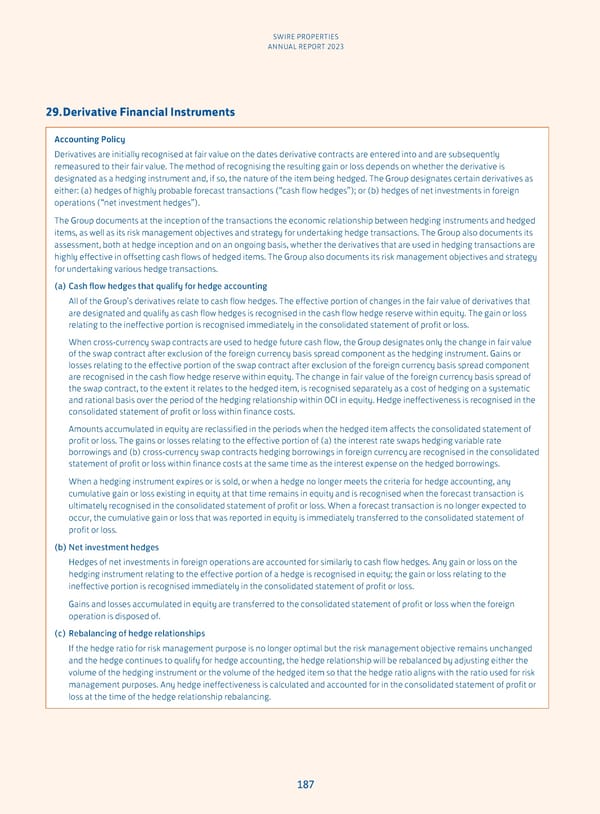SWIRE PROPERTIES ANNUAL REPORT 2023 29. Derivative Financial Instruments Accounting Policy Derivatives are initially recognised at fair value on the dates derivative contracts are entered into and are subsequently remeasured to their fair value. The method of recognising the resulting gain or loss depends on whether the derivative is designated as a hedging instrument and, if so, the nature of the item being hedged. The Group designates certain derivatives as either: (a) hedges of highly probable forecast transactions (“cash flow hedges”); or (b) hedges of net investments in foreign operations (“net investment hedges”). The Group documents at the inception of the transactions the economic relationship between hedging instruments and hedged items, as well as its risk management objectives and strategy for undertaking hedge transactions. The Group also documents its assessment, both at hedge inception and on an ongoing basis, whether the derivatives that are used in hedging transactions are highly effective in offsetting cash flows of hedged items. The Group also documents its risk management objectives and strategy for undertaking various hedge transactions. (a) Cash flow hedges that qualify for hedge accounting All of the Group’s derivatives relate to cash flow hedges. The effective portion of changes in the fair value of derivatives that are designated and qualify as cash flow hedges is recognised in the cash flow hedge reserve within equity. The gain or loss relating to the ineffective portion is recognised immediately in the consolidated statement of profit or loss. When cross-currency swap contracts are used to hedge future cash flow, the Group designates only the change in fair value of the swap contract after exclusion of the foreign currency basis spread component as the hedging instrument. Gains or losses relating to the effective portion of the swap contract after exclusion of the foreign currency basis spread component are recognised in the cash flow hedge reserve within equity. The change in fair value of the foreign currency basis spread of the swap contract, to the extent it relates to the hedged item, is recognised separately as a cost of hedging on a systematic and rational basis over the period of the hedging relationship within OCI in equity. Hedge ineffectiveness is recognised in the consolidated statement of profit or loss within finance costs. Amounts accumulated in equity are reclassified in the periods when the hedged item affects the consolidated statement of profit or loss. The gains or losses relating to the effective portion of (a) the interest rate swaps hedging variable rate borrowings and (b) cross-currency swap contracts hedging borrowings in foreign currency are recognised in the consolidated statement of profit or loss within finance costs at the same time as the interest expense on the hedged borrowings. When a hedging instrument expires or is sold, or when a hedge no longer meets the criteria for hedge accounting, any cumulative gain or loss existing in equity at that time remains in equity and is recognised when the forecast transaction is ultimately recognised in the consolidated statement of profit or loss. When a forecast transaction is no longer expected to occur, the cumulative gain or loss that was reported in equity is immediately transferred to the consolidated statement of profit or loss. (b) Net investment hedges Hedges of net investments in foreign operations are accounted for similarly to cash flow hedges. Any gain or loss on the hedging instrument relating to the effective portion of a hedge is recognised in equity; the gain or loss relating to the ineffective portion is recognised immediately in the consolidated statement of profit or loss. Gains and losses accumulated in equity are transferred to the consolidated statement of profit or loss when the foreign operation is disposed of. (c) Rebalancing of hedge relationships If the hedge ratio for risk management purpose is no longer optimal but the risk management objective remains unchanged and the hedge continues to qualify for hedge accounting, the hedge relationship will be rebalanced by adjusting either the volume of the hedging instrument or the volume of the hedged item so that the hedge ratio aligns with the ratio used for risk management purposes. Any hedge ineffectiveness is calculated and accounted for in the consolidated statement of profit or loss at the time of the hedge relationship rebalancing. 187
 Annual Report 2023 Page 188 Page 190
Annual Report 2023 Page 188 Page 190